Australian Industrial Relations: Qantas Industrial Dispute Analysis
VerifiedAdded on 2020/04/07
|13
|3595
|63
Report
AI Summary
This report provides an analysis of the 2017 Qantas industrial dispute involving the Australian Licenced Aircraft Engineers Association (ALAEA), the Transport Workers Union (TWU), and the Australian and International Pilots Association (AIPA). It examines the factual background of the dispute, including the negotiations for an enterprise agreement and the industrial actions taken by the unions. The report highlights key issues such as job security claims, the legality of contracting out, and the Fair Work Commission's role in arbitration. It explores the implications of the Fair Work Act, including restrictions on agreement content and the termination of industrial action. The analysis considers the actions of Qantas, the unions, and the Fair Work Australia, and evaluates the legal basis for the decisions made. The report concludes with an assessment of the dispute's impact on workplace regulations in Australia.
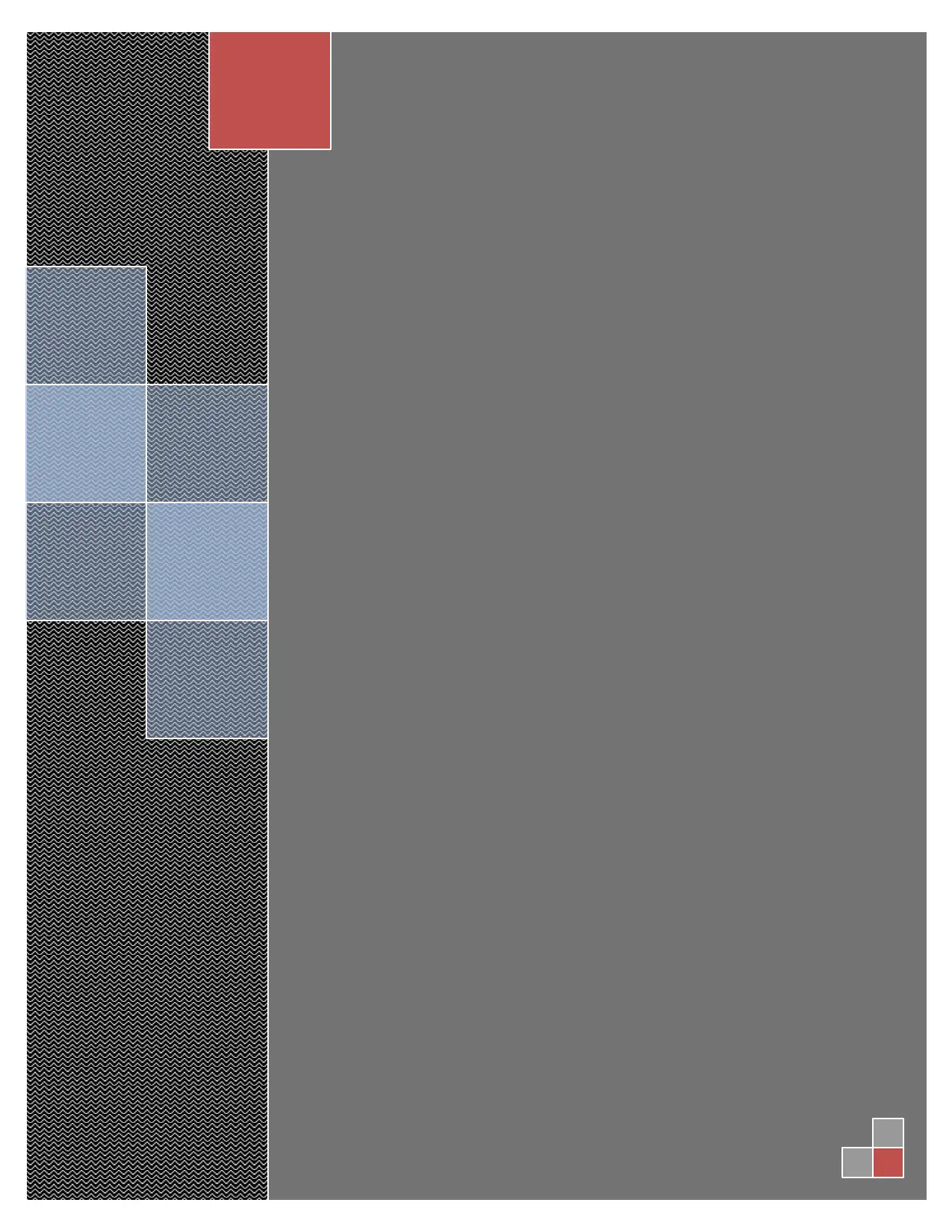
Paraphrase This Document
Need a fresh take? Get an instant paraphrase of this document with our AI Paraphraser
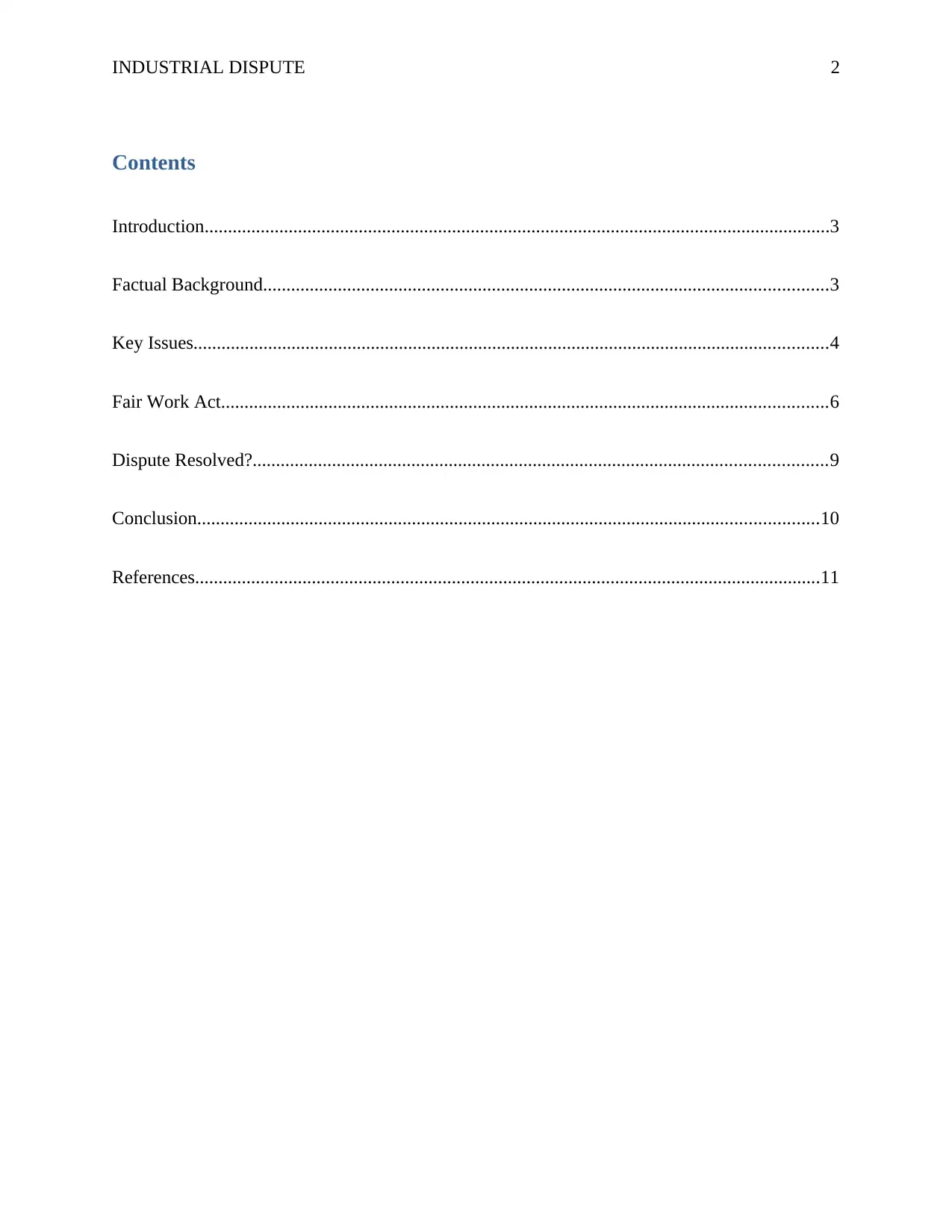
INDUSTRIAL DISPUTE 2
Contents
Introduction......................................................................................................................................3
Factual Background.........................................................................................................................3
Key Issues........................................................................................................................................4
Fair Work Act..................................................................................................................................6
Dispute Resolved?...........................................................................................................................9
Conclusion.....................................................................................................................................10
References......................................................................................................................................11
Contents
Introduction......................................................................................................................................3
Factual Background.........................................................................................................................3
Key Issues........................................................................................................................................4
Fair Work Act..................................................................................................................................6
Dispute Resolved?...........................................................................................................................9
Conclusion.....................................................................................................................................10
References......................................................................................................................................11
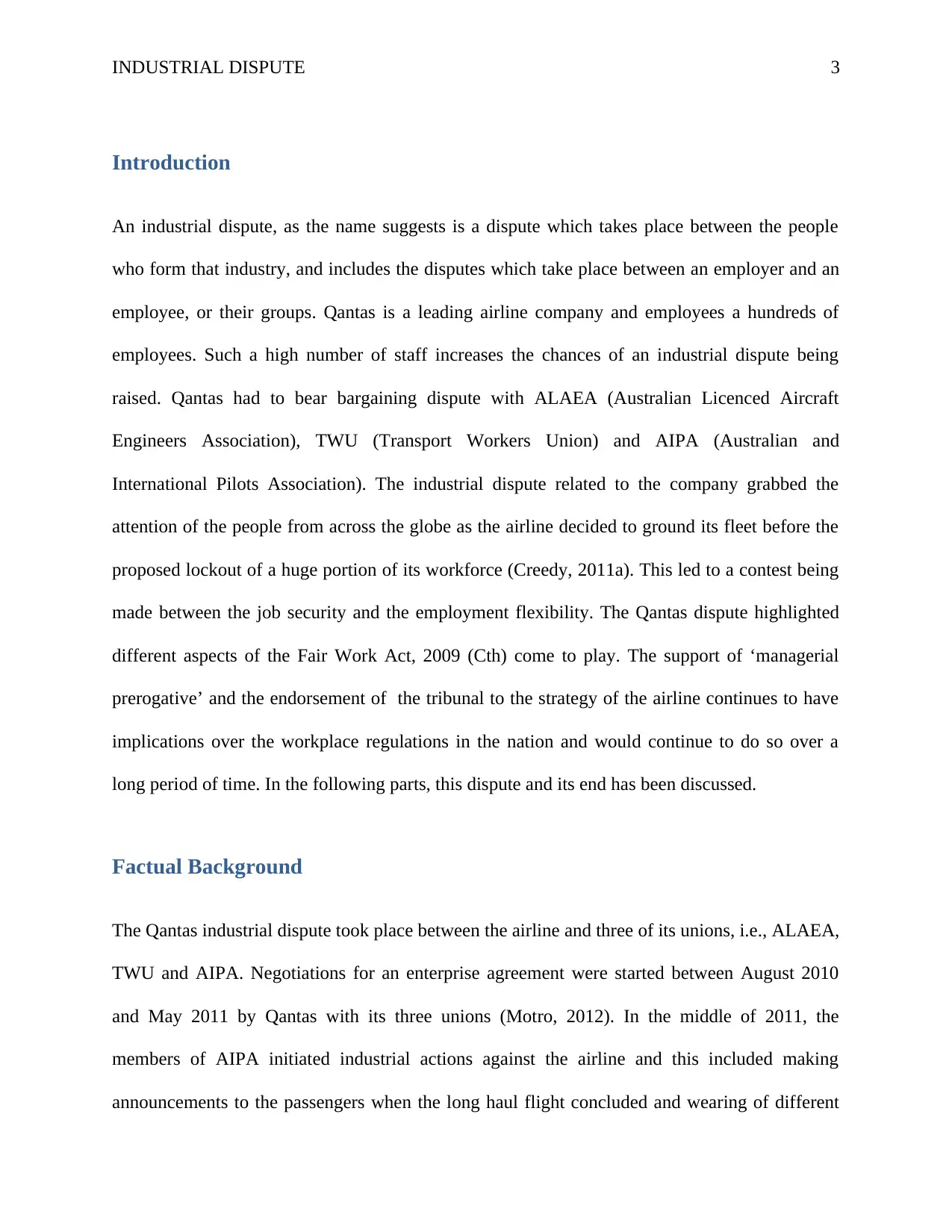
INDUSTRIAL DISPUTE 3
Introduction
An industrial dispute, as the name suggests is a dispute which takes place between the people
who form that industry, and includes the disputes which take place between an employer and an
employee, or their groups. Qantas is a leading airline company and employees a hundreds of
employees. Such a high number of staff increases the chances of an industrial dispute being
raised. Qantas had to bear bargaining dispute with ALAEA (Australian Licenced Aircraft
Engineers Association), TWU (Transport Workers Union) and AIPA (Australian and
International Pilots Association). The industrial dispute related to the company grabbed the
attention of the people from across the globe as the airline decided to ground its fleet before the
proposed lockout of a huge portion of its workforce (Creedy, 2011a). This led to a contest being
made between the job security and the employment flexibility. The Qantas dispute highlighted
different aspects of the Fair Work Act, 2009 (Cth) come to play. The support of ‘managerial
prerogative’ and the endorsement of the tribunal to the strategy of the airline continues to have
implications over the workplace regulations in the nation and would continue to do so over a
long period of time. In the following parts, this dispute and its end has been discussed.
Factual Background
The Qantas industrial dispute took place between the airline and three of its unions, i.e., ALAEA,
TWU and AIPA. Negotiations for an enterprise agreement were started between August 2010
and May 2011 by Qantas with its three unions (Motro, 2012). In the middle of 2011, the
members of AIPA initiated industrial actions against the airline and this included making
announcements to the passengers when the long haul flight concluded and wearing of different
Introduction
An industrial dispute, as the name suggests is a dispute which takes place between the people
who form that industry, and includes the disputes which take place between an employer and an
employee, or their groups. Qantas is a leading airline company and employees a hundreds of
employees. Such a high number of staff increases the chances of an industrial dispute being
raised. Qantas had to bear bargaining dispute with ALAEA (Australian Licenced Aircraft
Engineers Association), TWU (Transport Workers Union) and AIPA (Australian and
International Pilots Association). The industrial dispute related to the company grabbed the
attention of the people from across the globe as the airline decided to ground its fleet before the
proposed lockout of a huge portion of its workforce (Creedy, 2011a). This led to a contest being
made between the job security and the employment flexibility. The Qantas dispute highlighted
different aspects of the Fair Work Act, 2009 (Cth) come to play. The support of ‘managerial
prerogative’ and the endorsement of the tribunal to the strategy of the airline continues to have
implications over the workplace regulations in the nation and would continue to do so over a
long period of time. In the following parts, this dispute and its end has been discussed.
Factual Background
The Qantas industrial dispute took place between the airline and three of its unions, i.e., ALAEA,
TWU and AIPA. Negotiations for an enterprise agreement were started between August 2010
and May 2011 by Qantas with its three unions (Motro, 2012). In the middle of 2011, the
members of AIPA initiated industrial actions against the airline and this included making
announcements to the passengers when the long haul flight concluded and wearing of different
⊘ This is a preview!⊘
Do you want full access?
Subscribe today to unlock all pages.

Trusted by 1+ million students worldwide
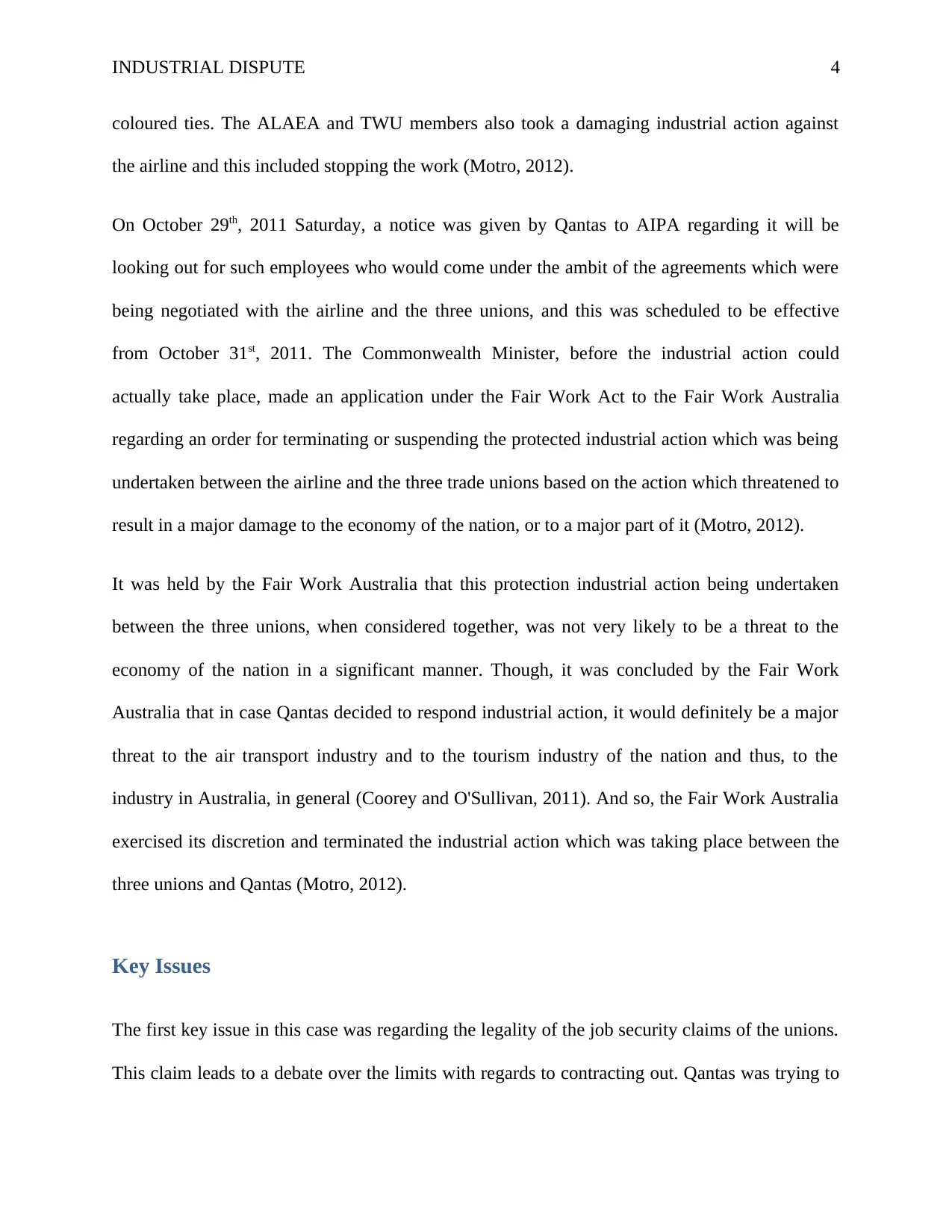
INDUSTRIAL DISPUTE 4
coloured ties. The ALAEA and TWU members also took a damaging industrial action against
the airline and this included stopping the work (Motro, 2012).
On October 29th, 2011 Saturday, a notice was given by Qantas to AIPA regarding it will be
looking out for such employees who would come under the ambit of the agreements which were
being negotiated with the airline and the three unions, and this was scheduled to be effective
from October 31st, 2011. The Commonwealth Minister, before the industrial action could
actually take place, made an application under the Fair Work Act to the Fair Work Australia
regarding an order for terminating or suspending the protected industrial action which was being
undertaken between the airline and the three trade unions based on the action which threatened to
result in a major damage to the economy of the nation, or to a major part of it (Motro, 2012).
It was held by the Fair Work Australia that this protection industrial action being undertaken
between the three unions, when considered together, was not very likely to be a threat to the
economy of the nation in a significant manner. Though, it was concluded by the Fair Work
Australia that in case Qantas decided to respond industrial action, it would definitely be a major
threat to the air transport industry and to the tourism industry of the nation and thus, to the
industry in Australia, in general (Coorey and O'Sullivan, 2011). And so, the Fair Work Australia
exercised its discretion and terminated the industrial action which was taking place between the
three unions and Qantas (Motro, 2012).
Key Issues
The first key issue in this case was regarding the legality of the job security claims of the unions.
This claim leads to a debate over the limits with regards to contracting out. Qantas was trying to
coloured ties. The ALAEA and TWU members also took a damaging industrial action against
the airline and this included stopping the work (Motro, 2012).
On October 29th, 2011 Saturday, a notice was given by Qantas to AIPA regarding it will be
looking out for such employees who would come under the ambit of the agreements which were
being negotiated with the airline and the three unions, and this was scheduled to be effective
from October 31st, 2011. The Commonwealth Minister, before the industrial action could
actually take place, made an application under the Fair Work Act to the Fair Work Australia
regarding an order for terminating or suspending the protected industrial action which was being
undertaken between the airline and the three trade unions based on the action which threatened to
result in a major damage to the economy of the nation, or to a major part of it (Motro, 2012).
It was held by the Fair Work Australia that this protection industrial action being undertaken
between the three unions, when considered together, was not very likely to be a threat to the
economy of the nation in a significant manner. Though, it was concluded by the Fair Work
Australia that in case Qantas decided to respond industrial action, it would definitely be a major
threat to the air transport industry and to the tourism industry of the nation and thus, to the
industry in Australia, in general (Coorey and O'Sullivan, 2011). And so, the Fair Work Australia
exercised its discretion and terminated the industrial action which was taking place between the
three unions and Qantas (Motro, 2012).
Key Issues
The first key issue in this case was regarding the legality of the job security claims of the unions.
This claim leads to a debate over the limits with regards to contracting out. Qantas was trying to
Paraphrase This Document
Need a fresh take? Get an instant paraphrase of this document with our AI Paraphraser
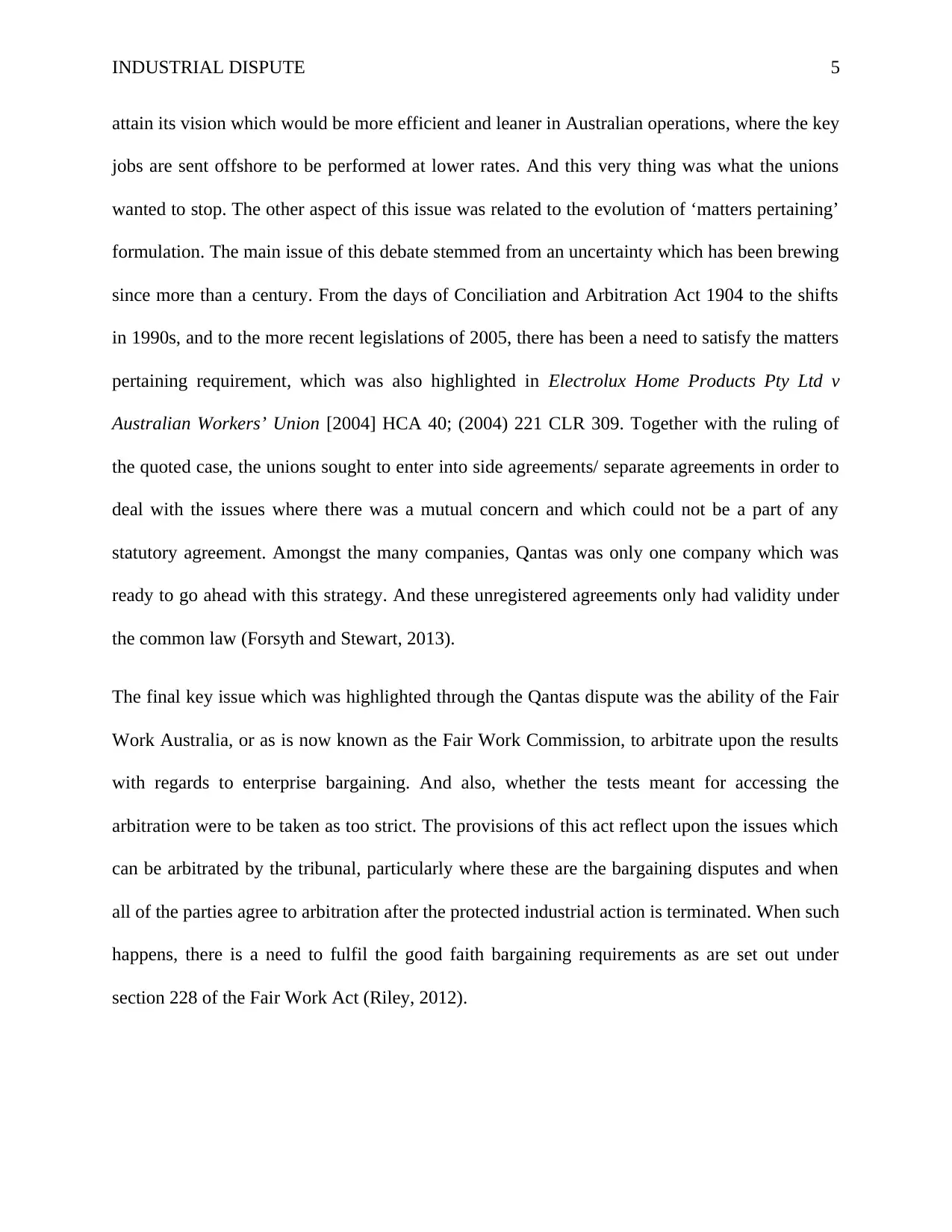
INDUSTRIAL DISPUTE 5
attain its vision which would be more efficient and leaner in Australian operations, where the key
jobs are sent offshore to be performed at lower rates. And this very thing was what the unions
wanted to stop. The other aspect of this issue was related to the evolution of ‘matters pertaining’
formulation. The main issue of this debate stemmed from an uncertainty which has been brewing
since more than a century. From the days of Conciliation and Arbitration Act 1904 to the shifts
in 1990s, and to the more recent legislations of 2005, there has been a need to satisfy the matters
pertaining requirement, which was also highlighted in Electrolux Home Products Pty Ltd v
Australian Workers’ Union [2004] HCA 40; (2004) 221 CLR 309. Together with the ruling of
the quoted case, the unions sought to enter into side agreements/ separate agreements in order to
deal with the issues where there was a mutual concern and which could not be a part of any
statutory agreement. Amongst the many companies, Qantas was only one company which was
ready to go ahead with this strategy. And these unregistered agreements only had validity under
the common law (Forsyth and Stewart, 2013).
The final key issue which was highlighted through the Qantas dispute was the ability of the Fair
Work Australia, or as is now known as the Fair Work Commission, to arbitrate upon the results
with regards to enterprise bargaining. And also, whether the tests meant for accessing the
arbitration were to be taken as too strict. The provisions of this act reflect upon the issues which
can be arbitrated by the tribunal, particularly where these are the bargaining disputes and when
all of the parties agree to arbitration after the protected industrial action is terminated. When such
happens, there is a need to fulfil the good faith bargaining requirements as are set out under
section 228 of the Fair Work Act (Riley, 2012).
attain its vision which would be more efficient and leaner in Australian operations, where the key
jobs are sent offshore to be performed at lower rates. And this very thing was what the unions
wanted to stop. The other aspect of this issue was related to the evolution of ‘matters pertaining’
formulation. The main issue of this debate stemmed from an uncertainty which has been brewing
since more than a century. From the days of Conciliation and Arbitration Act 1904 to the shifts
in 1990s, and to the more recent legislations of 2005, there has been a need to satisfy the matters
pertaining requirement, which was also highlighted in Electrolux Home Products Pty Ltd v
Australian Workers’ Union [2004] HCA 40; (2004) 221 CLR 309. Together with the ruling of
the quoted case, the unions sought to enter into side agreements/ separate agreements in order to
deal with the issues where there was a mutual concern and which could not be a part of any
statutory agreement. Amongst the many companies, Qantas was only one company which was
ready to go ahead with this strategy. And these unregistered agreements only had validity under
the common law (Forsyth and Stewart, 2013).
The final key issue which was highlighted through the Qantas dispute was the ability of the Fair
Work Australia, or as is now known as the Fair Work Commission, to arbitrate upon the results
with regards to enterprise bargaining. And also, whether the tests meant for accessing the
arbitration were to be taken as too strict. The provisions of this act reflect upon the issues which
can be arbitrated by the tribunal, particularly where these are the bargaining disputes and when
all of the parties agree to arbitration after the protected industrial action is terminated. When such
happens, there is a need to fulfil the good faith bargaining requirements as are set out under
section 228 of the Fair Work Act (Riley, 2012).
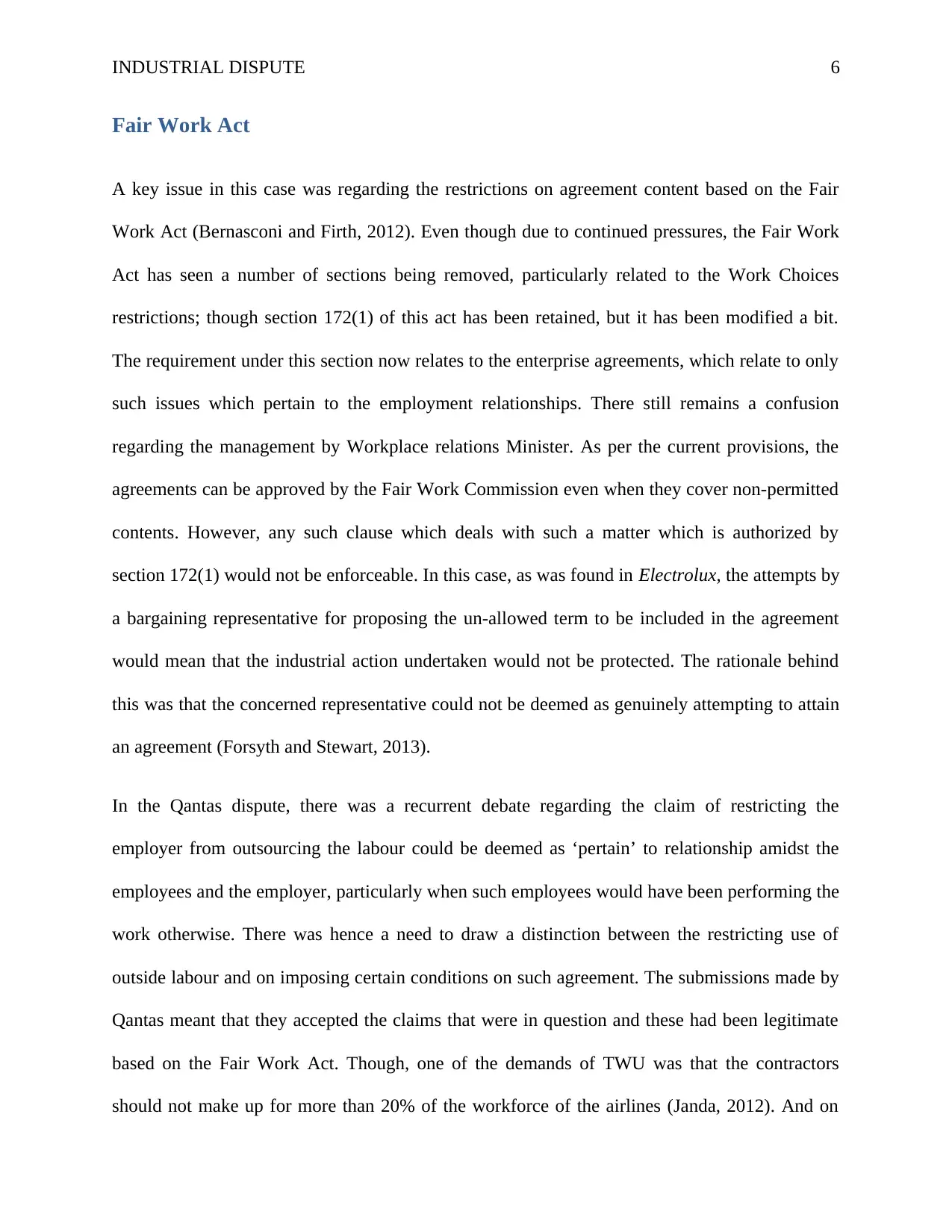
INDUSTRIAL DISPUTE 6
Fair Work Act
A key issue in this case was regarding the restrictions on agreement content based on the Fair
Work Act (Bernasconi and Firth, 2012). Even though due to continued pressures, the Fair Work
Act has seen a number of sections being removed, particularly related to the Work Choices
restrictions; though section 172(1) of this act has been retained, but it has been modified a bit.
The requirement under this section now relates to the enterprise agreements, which relate to only
such issues which pertain to the employment relationships. There still remains a confusion
regarding the management by Workplace relations Minister. As per the current provisions, the
agreements can be approved by the Fair Work Commission even when they cover non-permitted
contents. However, any such clause which deals with such a matter which is authorized by
section 172(1) would not be enforceable. In this case, as was found in Electrolux, the attempts by
a bargaining representative for proposing the un-allowed term to be included in the agreement
would mean that the industrial action undertaken would not be protected. The rationale behind
this was that the concerned representative could not be deemed as genuinely attempting to attain
an agreement (Forsyth and Stewart, 2013).
In the Qantas dispute, there was a recurrent debate regarding the claim of restricting the
employer from outsourcing the labour could be deemed as ‘pertain’ to relationship amidst the
employees and the employer, particularly when such employees would have been performing the
work otherwise. There was hence a need to draw a distinction between the restricting use of
outside labour and on imposing certain conditions on such agreement. The submissions made by
Qantas meant that they accepted the claims that were in question and these had been legitimate
based on the Fair Work Act. Though, one of the demands of TWU was that the contractors
should not make up for more than 20% of the workforce of the airlines (Janda, 2012). And on
Fair Work Act
A key issue in this case was regarding the restrictions on agreement content based on the Fair
Work Act (Bernasconi and Firth, 2012). Even though due to continued pressures, the Fair Work
Act has seen a number of sections being removed, particularly related to the Work Choices
restrictions; though section 172(1) of this act has been retained, but it has been modified a bit.
The requirement under this section now relates to the enterprise agreements, which relate to only
such issues which pertain to the employment relationships. There still remains a confusion
regarding the management by Workplace relations Minister. As per the current provisions, the
agreements can be approved by the Fair Work Commission even when they cover non-permitted
contents. However, any such clause which deals with such a matter which is authorized by
section 172(1) would not be enforceable. In this case, as was found in Electrolux, the attempts by
a bargaining representative for proposing the un-allowed term to be included in the agreement
would mean that the industrial action undertaken would not be protected. The rationale behind
this was that the concerned representative could not be deemed as genuinely attempting to attain
an agreement (Forsyth and Stewart, 2013).
In the Qantas dispute, there was a recurrent debate regarding the claim of restricting the
employer from outsourcing the labour could be deemed as ‘pertain’ to relationship amidst the
employees and the employer, particularly when such employees would have been performing the
work otherwise. There was hence a need to draw a distinction between the restricting use of
outside labour and on imposing certain conditions on such agreement. The submissions made by
Qantas meant that they accepted the claims that were in question and these had been legitimate
based on the Fair Work Act. Though, one of the demands of TWU was that the contractors
should not make up for more than 20% of the workforce of the airlines (Janda, 2012). And on
⊘ This is a preview!⊘
Do you want full access?
Subscribe today to unlock all pages.

Trusted by 1+ million students worldwide
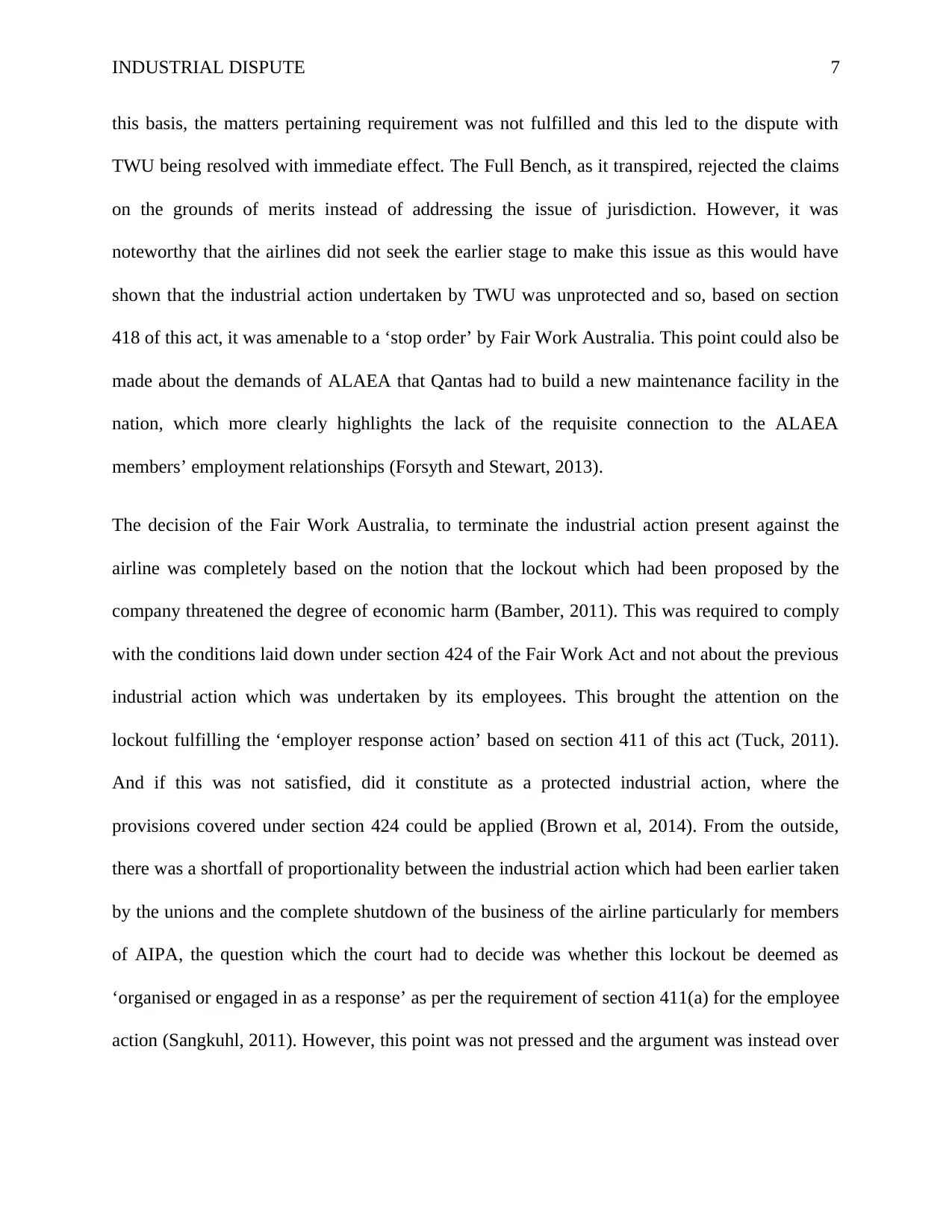
INDUSTRIAL DISPUTE 7
this basis, the matters pertaining requirement was not fulfilled and this led to the dispute with
TWU being resolved with immediate effect. The Full Bench, as it transpired, rejected the claims
on the grounds of merits instead of addressing the issue of jurisdiction. However, it was
noteworthy that the airlines did not seek the earlier stage to make this issue as this would have
shown that the industrial action undertaken by TWU was unprotected and so, based on section
418 of this act, it was amenable to a ‘stop order’ by Fair Work Australia. This point could also be
made about the demands of ALAEA that Qantas had to build a new maintenance facility in the
nation, which more clearly highlights the lack of the requisite connection to the ALAEA
members’ employment relationships (Forsyth and Stewart, 2013).
The decision of the Fair Work Australia, to terminate the industrial action present against the
airline was completely based on the notion that the lockout which had been proposed by the
company threatened the degree of economic harm (Bamber, 2011). This was required to comply
with the conditions laid down under section 424 of the Fair Work Act and not about the previous
industrial action which was undertaken by its employees. This brought the attention on the
lockout fulfilling the ‘employer response action’ based on section 411 of this act (Tuck, 2011).
And if this was not satisfied, did it constitute as a protected industrial action, where the
provisions covered under section 424 could be applied (Brown et al, 2014). From the outside,
there was a shortfall of proportionality between the industrial action which had been earlier taken
by the unions and the complete shutdown of the business of the airline particularly for members
of AIPA, the question which the court had to decide was whether this lockout be deemed as
‘organised or engaged in as a response’ as per the requirement of section 411(a) for the employee
action (Sangkuhl, 2011). However, this point was not pressed and the argument was instead over
this basis, the matters pertaining requirement was not fulfilled and this led to the dispute with
TWU being resolved with immediate effect. The Full Bench, as it transpired, rejected the claims
on the grounds of merits instead of addressing the issue of jurisdiction. However, it was
noteworthy that the airlines did not seek the earlier stage to make this issue as this would have
shown that the industrial action undertaken by TWU was unprotected and so, based on section
418 of this act, it was amenable to a ‘stop order’ by Fair Work Australia. This point could also be
made about the demands of ALAEA that Qantas had to build a new maintenance facility in the
nation, which more clearly highlights the lack of the requisite connection to the ALAEA
members’ employment relationships (Forsyth and Stewart, 2013).
The decision of the Fair Work Australia, to terminate the industrial action present against the
airline was completely based on the notion that the lockout which had been proposed by the
company threatened the degree of economic harm (Bamber, 2011). This was required to comply
with the conditions laid down under section 424 of the Fair Work Act and not about the previous
industrial action which was undertaken by its employees. This brought the attention on the
lockout fulfilling the ‘employer response action’ based on section 411 of this act (Tuck, 2011).
And if this was not satisfied, did it constitute as a protected industrial action, where the
provisions covered under section 424 could be applied (Brown et al, 2014). From the outside,
there was a shortfall of proportionality between the industrial action which had been earlier taken
by the unions and the complete shutdown of the business of the airline particularly for members
of AIPA, the question which the court had to decide was whether this lockout be deemed as
‘organised or engaged in as a response’ as per the requirement of section 411(a) for the employee
action (Sangkuhl, 2011). However, this point was not pressed and the argument was instead over
Paraphrase This Document
Need a fresh take? Get an instant paraphrase of this document with our AI Paraphraser
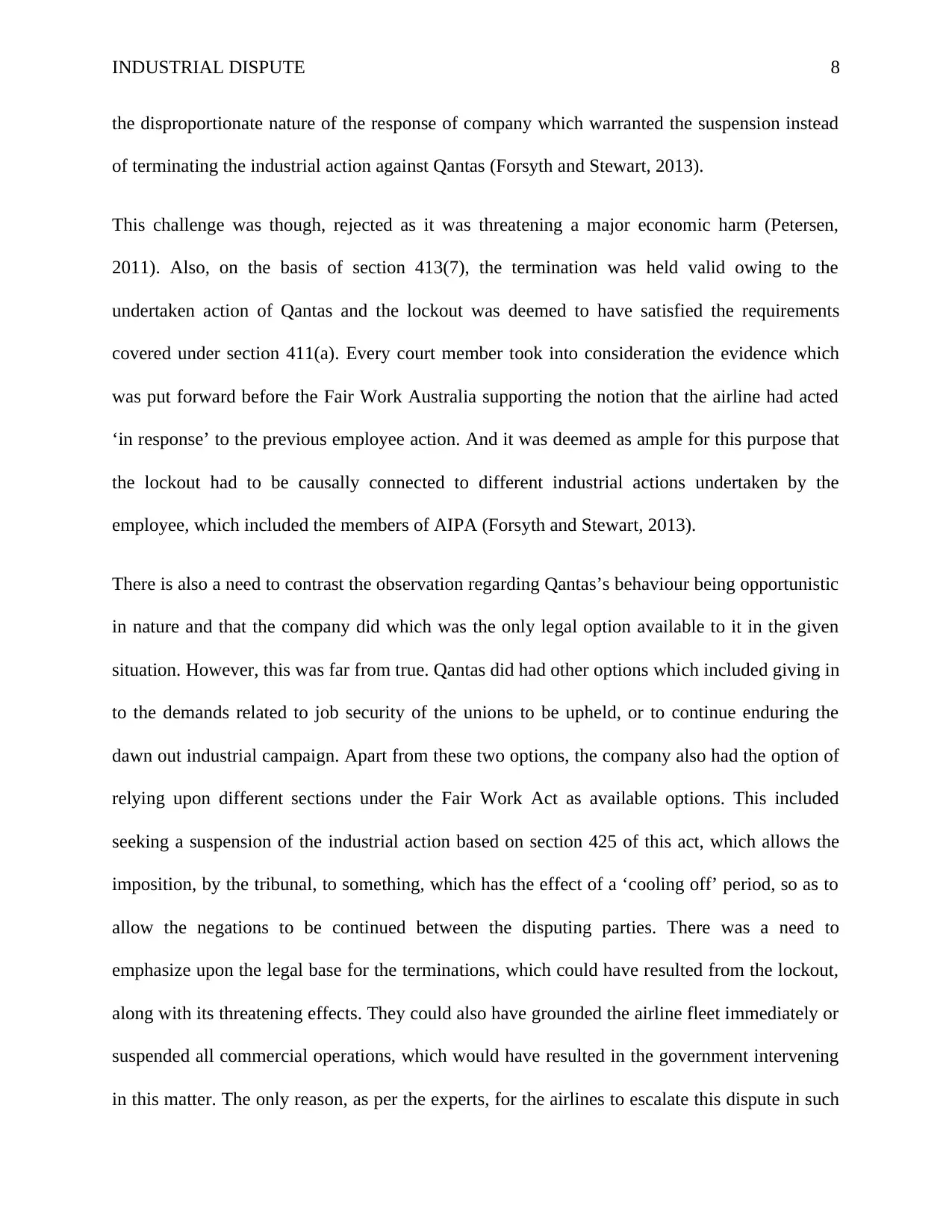
INDUSTRIAL DISPUTE 8
the disproportionate nature of the response of company which warranted the suspension instead
of terminating the industrial action against Qantas (Forsyth and Stewart, 2013).
This challenge was though, rejected as it was threatening a major economic harm (Petersen,
2011). Also, on the basis of section 413(7), the termination was held valid owing to the
undertaken action of Qantas and the lockout was deemed to have satisfied the requirements
covered under section 411(a). Every court member took into consideration the evidence which
was put forward before the Fair Work Australia supporting the notion that the airline had acted
‘in response’ to the previous employee action. And it was deemed as ample for this purpose that
the lockout had to be causally connected to different industrial actions undertaken by the
employee, which included the members of AIPA (Forsyth and Stewart, 2013).
There is also a need to contrast the observation regarding Qantas’s behaviour being opportunistic
in nature and that the company did which was the only legal option available to it in the given
situation. However, this was far from true. Qantas did had other options which included giving in
to the demands related to job security of the unions to be upheld, or to continue enduring the
dawn out industrial campaign. Apart from these two options, the company also had the option of
relying upon different sections under the Fair Work Act as available options. This included
seeking a suspension of the industrial action based on section 425 of this act, which allows the
imposition, by the tribunal, to something, which has the effect of a ‘cooling off’ period, so as to
allow the negations to be continued between the disputing parties. There was a need to
emphasize upon the legal base for the terminations, which could have resulted from the lockout,
along with its threatening effects. They could also have grounded the airline fleet immediately or
suspended all commercial operations, which would have resulted in the government intervening
in this matter. The only reason, as per the experts, for the airlines to escalate this dispute in such
the disproportionate nature of the response of company which warranted the suspension instead
of terminating the industrial action against Qantas (Forsyth and Stewart, 2013).
This challenge was though, rejected as it was threatening a major economic harm (Petersen,
2011). Also, on the basis of section 413(7), the termination was held valid owing to the
undertaken action of Qantas and the lockout was deemed to have satisfied the requirements
covered under section 411(a). Every court member took into consideration the evidence which
was put forward before the Fair Work Australia supporting the notion that the airline had acted
‘in response’ to the previous employee action. And it was deemed as ample for this purpose that
the lockout had to be causally connected to different industrial actions undertaken by the
employee, which included the members of AIPA (Forsyth and Stewart, 2013).
There is also a need to contrast the observation regarding Qantas’s behaviour being opportunistic
in nature and that the company did which was the only legal option available to it in the given
situation. However, this was far from true. Qantas did had other options which included giving in
to the demands related to job security of the unions to be upheld, or to continue enduring the
dawn out industrial campaign. Apart from these two options, the company also had the option of
relying upon different sections under the Fair Work Act as available options. This included
seeking a suspension of the industrial action based on section 425 of this act, which allows the
imposition, by the tribunal, to something, which has the effect of a ‘cooling off’ period, so as to
allow the negations to be continued between the disputing parties. There was a need to
emphasize upon the legal base for the terminations, which could have resulted from the lockout,
along with its threatening effects. They could also have grounded the airline fleet immediately or
suspended all commercial operations, which would have resulted in the government intervening
in this matter. The only reason, as per the experts, for the airlines to escalate this dispute in such
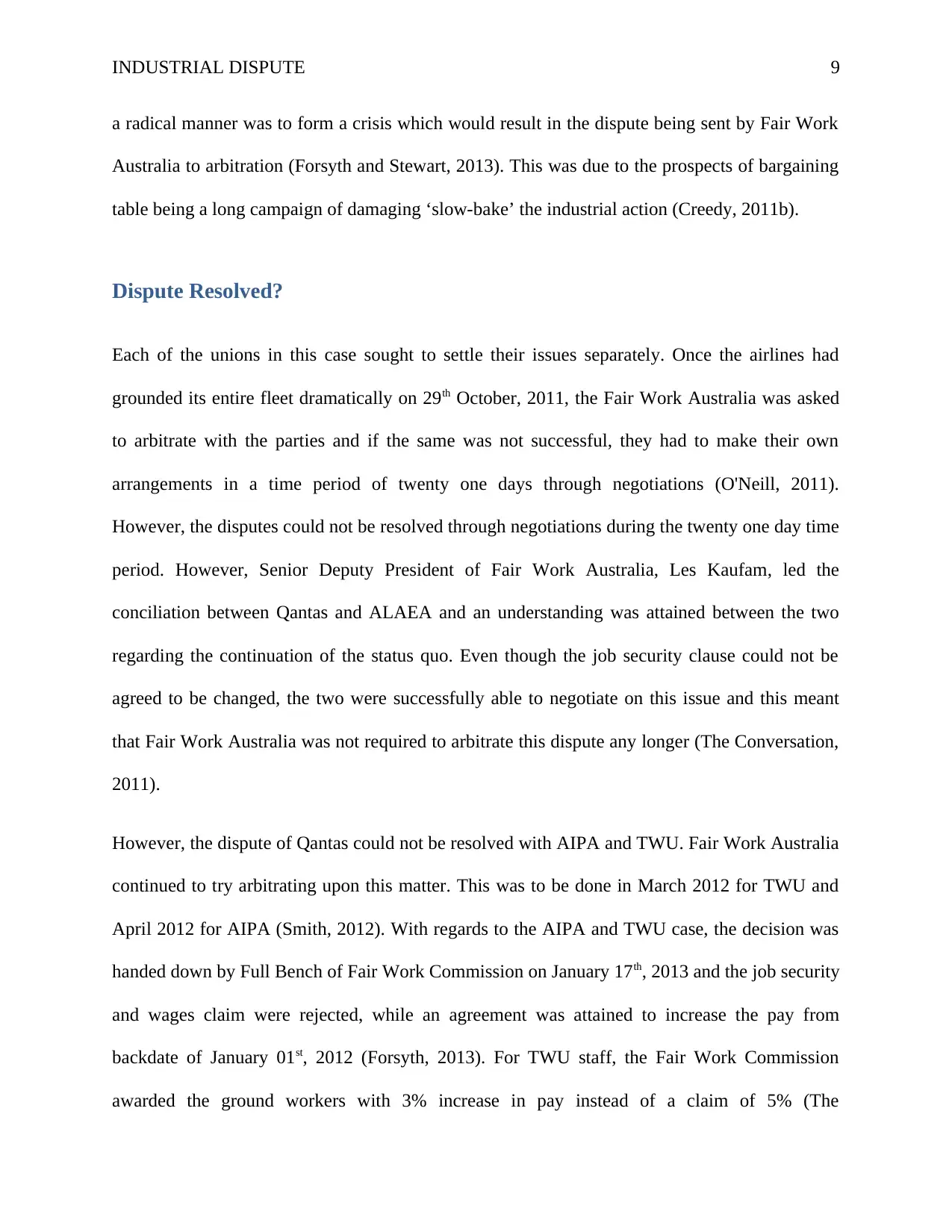
INDUSTRIAL DISPUTE 9
a radical manner was to form a crisis which would result in the dispute being sent by Fair Work
Australia to arbitration (Forsyth and Stewart, 2013). This was due to the prospects of bargaining
table being a long campaign of damaging ‘slow-bake’ the industrial action (Creedy, 2011b).
Dispute Resolved?
Each of the unions in this case sought to settle their issues separately. Once the airlines had
grounded its entire fleet dramatically on 29th October, 2011, the Fair Work Australia was asked
to arbitrate with the parties and if the same was not successful, they had to make their own
arrangements in a time period of twenty one days through negotiations (O'Neill, 2011).
However, the disputes could not be resolved through negotiations during the twenty one day time
period. However, Senior Deputy President of Fair Work Australia, Les Kaufam, led the
conciliation between Qantas and ALAEA and an understanding was attained between the two
regarding the continuation of the status quo. Even though the job security clause could not be
agreed to be changed, the two were successfully able to negotiate on this issue and this meant
that Fair Work Australia was not required to arbitrate this dispute any longer (The Conversation,
2011).
However, the dispute of Qantas could not be resolved with AIPA and TWU. Fair Work Australia
continued to try arbitrating upon this matter. This was to be done in March 2012 for TWU and
April 2012 for AIPA (Smith, 2012). With regards to the AIPA and TWU case, the decision was
handed down by Full Bench of Fair Work Commission on January 17th, 2013 and the job security
and wages claim were rejected, while an agreement was attained to increase the pay from
backdate of January 01st, 2012 (Forsyth, 2013). For TWU staff, the Fair Work Commission
awarded the ground workers with 3% increase in pay instead of a claim of 5% (The
a radical manner was to form a crisis which would result in the dispute being sent by Fair Work
Australia to arbitration (Forsyth and Stewart, 2013). This was due to the prospects of bargaining
table being a long campaign of damaging ‘slow-bake’ the industrial action (Creedy, 2011b).
Dispute Resolved?
Each of the unions in this case sought to settle their issues separately. Once the airlines had
grounded its entire fleet dramatically on 29th October, 2011, the Fair Work Australia was asked
to arbitrate with the parties and if the same was not successful, they had to make their own
arrangements in a time period of twenty one days through negotiations (O'Neill, 2011).
However, the disputes could not be resolved through negotiations during the twenty one day time
period. However, Senior Deputy President of Fair Work Australia, Les Kaufam, led the
conciliation between Qantas and ALAEA and an understanding was attained between the two
regarding the continuation of the status quo. Even though the job security clause could not be
agreed to be changed, the two were successfully able to negotiate on this issue and this meant
that Fair Work Australia was not required to arbitrate this dispute any longer (The Conversation,
2011).
However, the dispute of Qantas could not be resolved with AIPA and TWU. Fair Work Australia
continued to try arbitrating upon this matter. This was to be done in March 2012 for TWU and
April 2012 for AIPA (Smith, 2012). With regards to the AIPA and TWU case, the decision was
handed down by Full Bench of Fair Work Commission on January 17th, 2013 and the job security
and wages claim were rejected, while an agreement was attained to increase the pay from
backdate of January 01st, 2012 (Forsyth, 2013). For TWU staff, the Fair Work Commission
awarded the ground workers with 3% increase in pay instead of a claim of 5% (The
⊘ This is a preview!⊘
Do you want full access?
Subscribe today to unlock all pages.

Trusted by 1+ million students worldwide
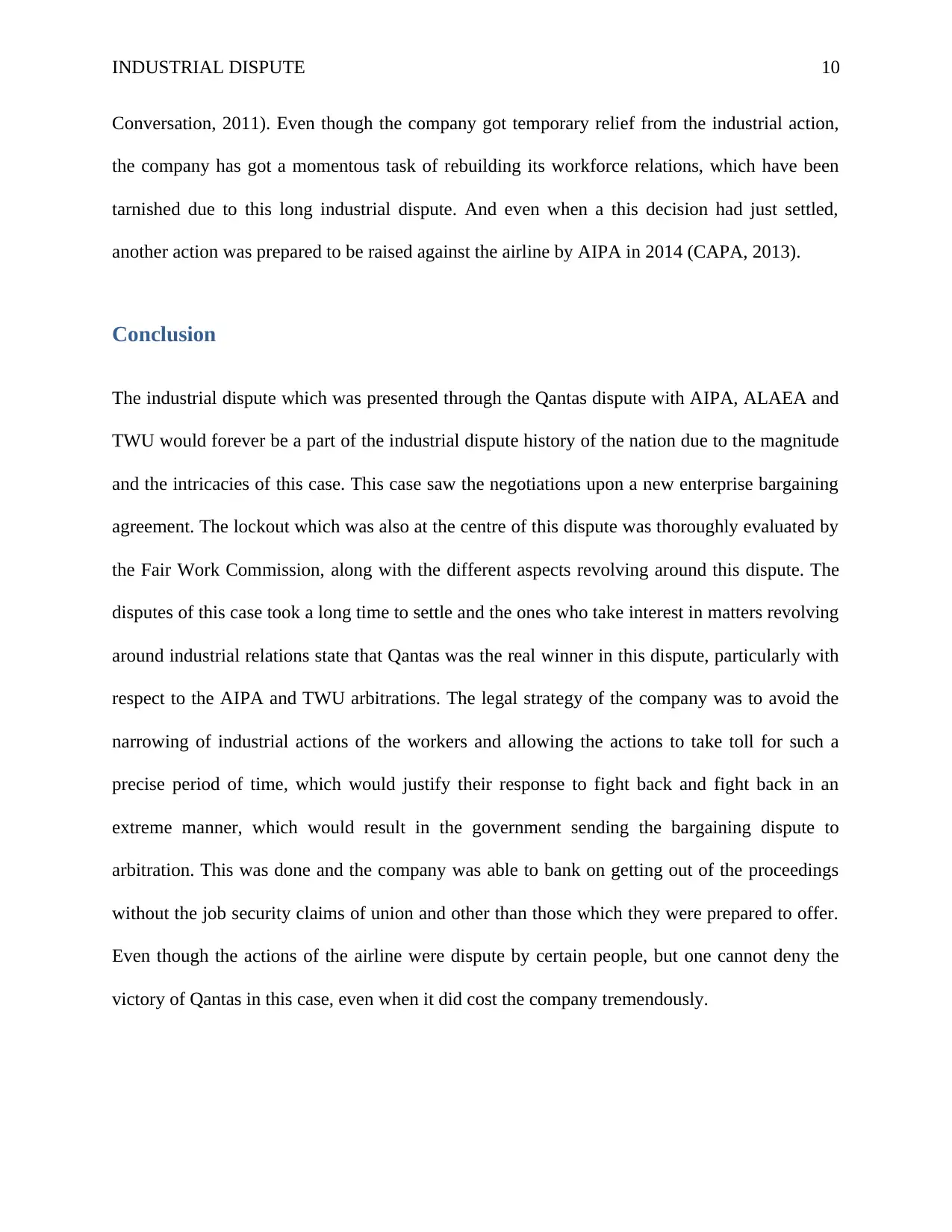
INDUSTRIAL DISPUTE 10
Conversation, 2011). Even though the company got temporary relief from the industrial action,
the company has got a momentous task of rebuilding its workforce relations, which have been
tarnished due to this long industrial dispute. And even when a this decision had just settled,
another action was prepared to be raised against the airline by AIPA in 2014 (CAPA, 2013).
Conclusion
The industrial dispute which was presented through the Qantas dispute with AIPA, ALAEA and
TWU would forever be a part of the industrial dispute history of the nation due to the magnitude
and the intricacies of this case. This case saw the negotiations upon a new enterprise bargaining
agreement. The lockout which was also at the centre of this dispute was thoroughly evaluated by
the Fair Work Commission, along with the different aspects revolving around this dispute. The
disputes of this case took a long time to settle and the ones who take interest in matters revolving
around industrial relations state that Qantas was the real winner in this dispute, particularly with
respect to the AIPA and TWU arbitrations. The legal strategy of the company was to avoid the
narrowing of industrial actions of the workers and allowing the actions to take toll for such a
precise period of time, which would justify their response to fight back and fight back in an
extreme manner, which would result in the government sending the bargaining dispute to
arbitration. This was done and the company was able to bank on getting out of the proceedings
without the job security claims of union and other than those which they were prepared to offer.
Even though the actions of the airline were dispute by certain people, but one cannot deny the
victory of Qantas in this case, even when it did cost the company tremendously.
Conversation, 2011). Even though the company got temporary relief from the industrial action,
the company has got a momentous task of rebuilding its workforce relations, which have been
tarnished due to this long industrial dispute. And even when a this decision had just settled,
another action was prepared to be raised against the airline by AIPA in 2014 (CAPA, 2013).
Conclusion
The industrial dispute which was presented through the Qantas dispute with AIPA, ALAEA and
TWU would forever be a part of the industrial dispute history of the nation due to the magnitude
and the intricacies of this case. This case saw the negotiations upon a new enterprise bargaining
agreement. The lockout which was also at the centre of this dispute was thoroughly evaluated by
the Fair Work Commission, along with the different aspects revolving around this dispute. The
disputes of this case took a long time to settle and the ones who take interest in matters revolving
around industrial relations state that Qantas was the real winner in this dispute, particularly with
respect to the AIPA and TWU arbitrations. The legal strategy of the company was to avoid the
narrowing of industrial actions of the workers and allowing the actions to take toll for such a
precise period of time, which would justify their response to fight back and fight back in an
extreme manner, which would result in the government sending the bargaining dispute to
arbitration. This was done and the company was able to bank on getting out of the proceedings
without the job security claims of union and other than those which they were prepared to offer.
Even though the actions of the airline were dispute by certain people, but one cannot deny the
victory of Qantas in this case, even when it did cost the company tremendously.
Paraphrase This Document
Need a fresh take? Get an instant paraphrase of this document with our AI Paraphraser
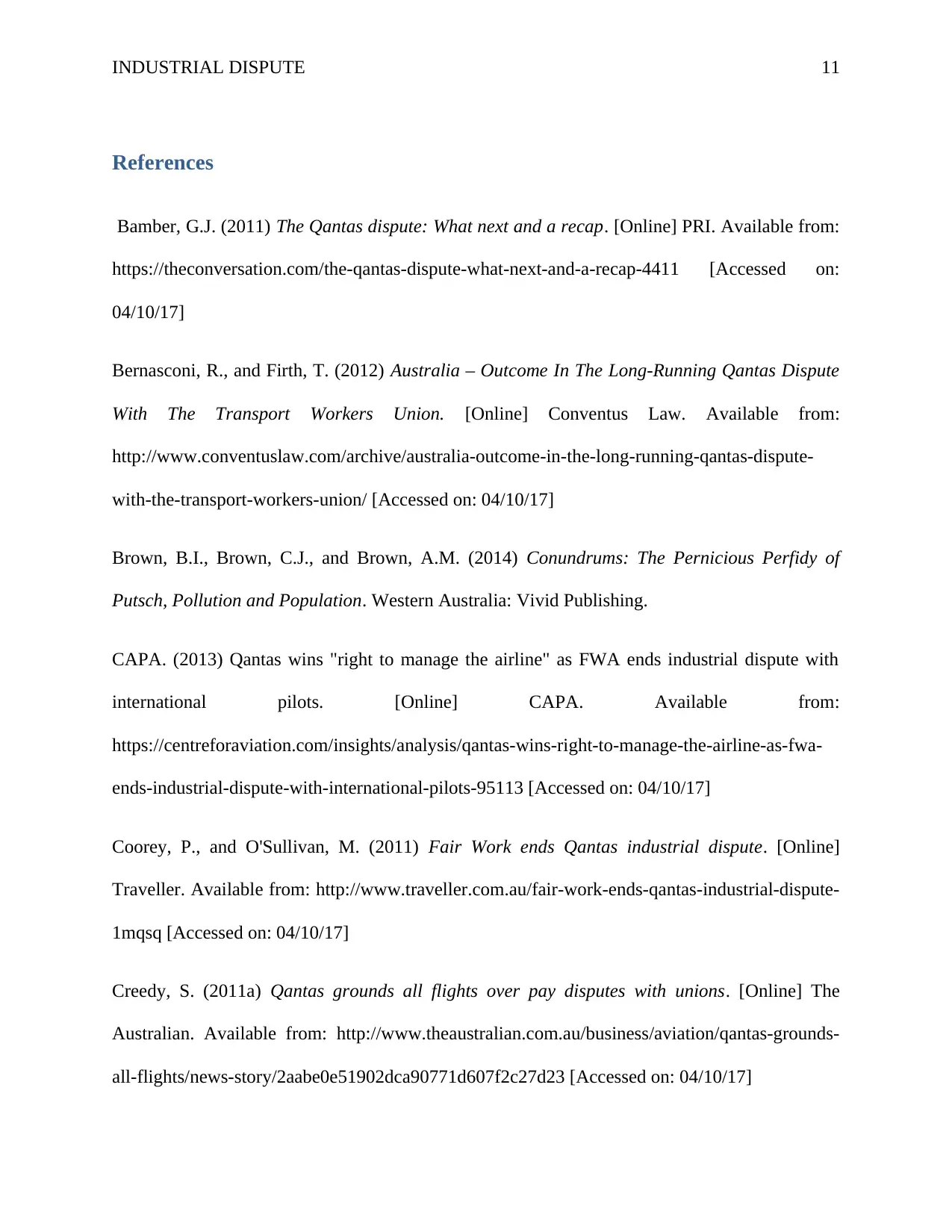
INDUSTRIAL DISPUTE 11
References
Bamber, G.J. (2011) The Qantas dispute: What next and a recap. [Online] PRI. Available from:
https://theconversation.com/the-qantas-dispute-what-next-and-a-recap-4411 [Accessed on:
04/10/17]
Bernasconi, R., and Firth, T. (2012) Australia – Outcome In The Long-Running Qantas Dispute
With The Transport Workers Union. [Online] Conventus Law. Available from:
http://www.conventuslaw.com/archive/australia-outcome-in-the-long-running-qantas-dispute-
with-the-transport-workers-union/ [Accessed on: 04/10/17]
Brown, B.I., Brown, C.J., and Brown, A.M. (2014) Conundrums: The Pernicious Perfidy of
Putsch, Pollution and Population. Western Australia: Vivid Publishing.
CAPA. (2013) Qantas wins "right to manage the airline" as FWA ends industrial dispute with
international pilots. [Online] CAPA. Available from:
https://centreforaviation.com/insights/analysis/qantas-wins-right-to-manage-the-airline-as-fwa-
ends-industrial-dispute-with-international-pilots-95113 [Accessed on: 04/10/17]
Coorey, P., and O'Sullivan, M. (2011) Fair Work ends Qantas industrial dispute. [Online]
Traveller. Available from: http://www.traveller.com.au/fair-work-ends-qantas-industrial-dispute-
1mqsq [Accessed on: 04/10/17]
Creedy, S. (2011a) Qantas grounds all flights over pay disputes with unions. [Online] The
Australian. Available from: http://www.theaustralian.com.au/business/aviation/qantas-grounds-
all-flights/news-story/2aabe0e51902dca90771d607f2c27d23 [Accessed on: 04/10/17]
References
Bamber, G.J. (2011) The Qantas dispute: What next and a recap. [Online] PRI. Available from:
https://theconversation.com/the-qantas-dispute-what-next-and-a-recap-4411 [Accessed on:
04/10/17]
Bernasconi, R., and Firth, T. (2012) Australia – Outcome In The Long-Running Qantas Dispute
With The Transport Workers Union. [Online] Conventus Law. Available from:
http://www.conventuslaw.com/archive/australia-outcome-in-the-long-running-qantas-dispute-
with-the-transport-workers-union/ [Accessed on: 04/10/17]
Brown, B.I., Brown, C.J., and Brown, A.M. (2014) Conundrums: The Pernicious Perfidy of
Putsch, Pollution and Population. Western Australia: Vivid Publishing.
CAPA. (2013) Qantas wins "right to manage the airline" as FWA ends industrial dispute with
international pilots. [Online] CAPA. Available from:
https://centreforaviation.com/insights/analysis/qantas-wins-right-to-manage-the-airline-as-fwa-
ends-industrial-dispute-with-international-pilots-95113 [Accessed on: 04/10/17]
Coorey, P., and O'Sullivan, M. (2011) Fair Work ends Qantas industrial dispute. [Online]
Traveller. Available from: http://www.traveller.com.au/fair-work-ends-qantas-industrial-dispute-
1mqsq [Accessed on: 04/10/17]
Creedy, S. (2011a) Qantas grounds all flights over pay disputes with unions. [Online] The
Australian. Available from: http://www.theaustralian.com.au/business/aviation/qantas-grounds-
all-flights/news-story/2aabe0e51902dca90771d607f2c27d23 [Accessed on: 04/10/17]
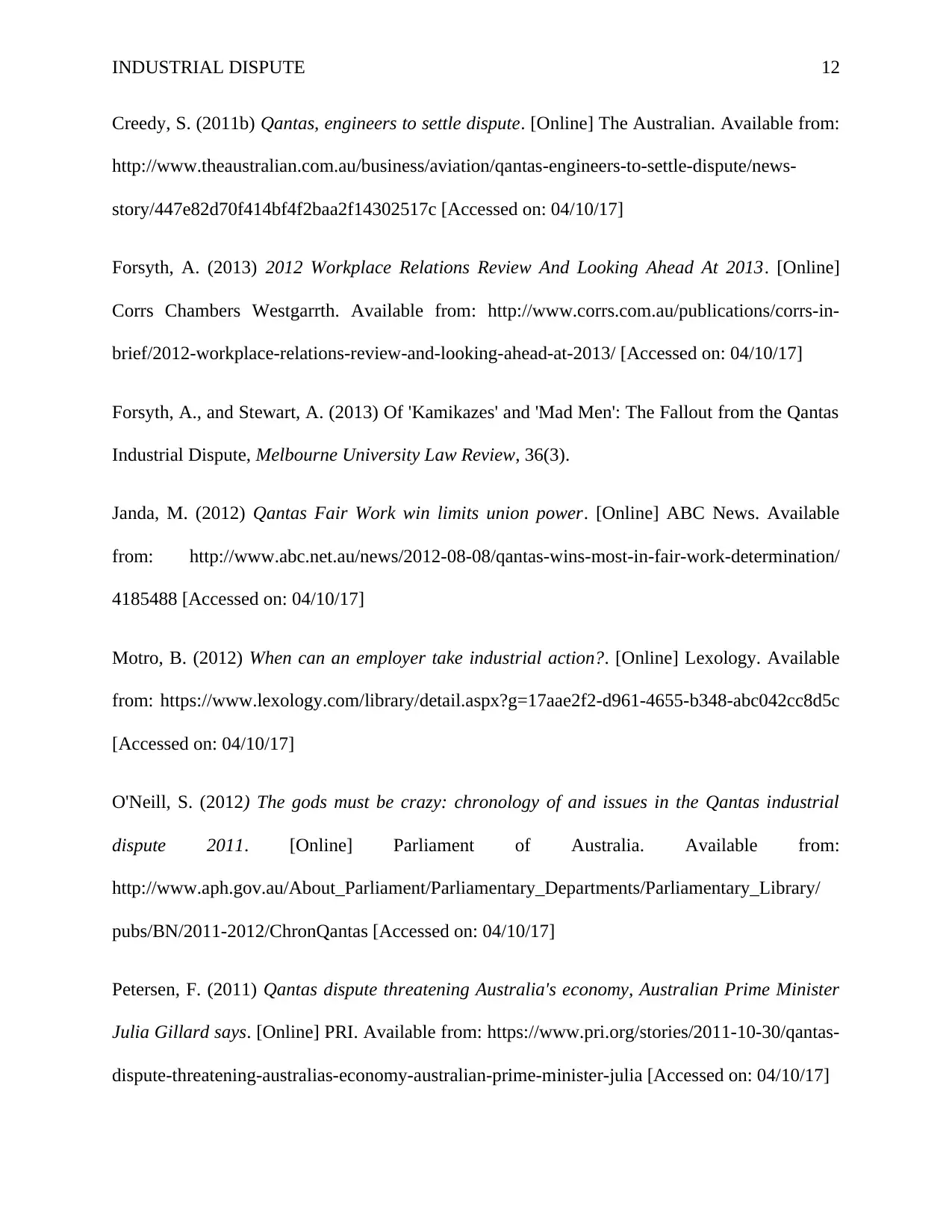
INDUSTRIAL DISPUTE 12
Creedy, S. (2011b) Qantas, engineers to settle dispute. [Online] The Australian. Available from:
http://www.theaustralian.com.au/business/aviation/qantas-engineers-to-settle-dispute/news-
story/447e82d70f414bf4f2baa2f14302517c [Accessed on: 04/10/17]
Forsyth, A. (2013) 2012 Workplace Relations Review And Looking Ahead At 2013. [Online]
Corrs Chambers Westgarrth. Available from: http://www.corrs.com.au/publications/corrs-in-
brief/2012-workplace-relations-review-and-looking-ahead-at-2013/ [Accessed on: 04/10/17]
Forsyth, A., and Stewart, A. (2013) Of 'Kamikazes' and 'Mad Men': The Fallout from the Qantas
Industrial Dispute, Melbourne University Law Review, 36(3).
Janda, M. (2012) Qantas Fair Work win limits union power. [Online] ABC News. Available
from: http://www.abc.net.au/news/2012-08-08/qantas-wins-most-in-fair-work-determination/
4185488 [Accessed on: 04/10/17]
Motro, B. (2012) When can an employer take industrial action?. [Online] Lexology. Available
from: https://www.lexology.com/library/detail.aspx?g=17aae2f2-d961-4655-b348-abc042cc8d5c
[Accessed on: 04/10/17]
O'Neill, S. (2012) The gods must be crazy: chronology of and issues in the Qantas industrial
dispute 2011. [Online] Parliament of Australia. Available from:
http://www.aph.gov.au/About_Parliament/Parliamentary_Departments/Parliamentary_Library/
pubs/BN/2011-2012/ChronQantas [Accessed on: 04/10/17]
Petersen, F. (2011) Qantas dispute threatening Australia's economy, Australian Prime Minister
Julia Gillard says. [Online] PRI. Available from: https://www.pri.org/stories/2011-10-30/qantas-
dispute-threatening-australias-economy-australian-prime-minister-julia [Accessed on: 04/10/17]
Creedy, S. (2011b) Qantas, engineers to settle dispute. [Online] The Australian. Available from:
http://www.theaustralian.com.au/business/aviation/qantas-engineers-to-settle-dispute/news-
story/447e82d70f414bf4f2baa2f14302517c [Accessed on: 04/10/17]
Forsyth, A. (2013) 2012 Workplace Relations Review And Looking Ahead At 2013. [Online]
Corrs Chambers Westgarrth. Available from: http://www.corrs.com.au/publications/corrs-in-
brief/2012-workplace-relations-review-and-looking-ahead-at-2013/ [Accessed on: 04/10/17]
Forsyth, A., and Stewart, A. (2013) Of 'Kamikazes' and 'Mad Men': The Fallout from the Qantas
Industrial Dispute, Melbourne University Law Review, 36(3).
Janda, M. (2012) Qantas Fair Work win limits union power. [Online] ABC News. Available
from: http://www.abc.net.au/news/2012-08-08/qantas-wins-most-in-fair-work-determination/
4185488 [Accessed on: 04/10/17]
Motro, B. (2012) When can an employer take industrial action?. [Online] Lexology. Available
from: https://www.lexology.com/library/detail.aspx?g=17aae2f2-d961-4655-b348-abc042cc8d5c
[Accessed on: 04/10/17]
O'Neill, S. (2012) The gods must be crazy: chronology of and issues in the Qantas industrial
dispute 2011. [Online] Parliament of Australia. Available from:
http://www.aph.gov.au/About_Parliament/Parliamentary_Departments/Parliamentary_Library/
pubs/BN/2011-2012/ChronQantas [Accessed on: 04/10/17]
Petersen, F. (2011) Qantas dispute threatening Australia's economy, Australian Prime Minister
Julia Gillard says. [Online] PRI. Available from: https://www.pri.org/stories/2011-10-30/qantas-
dispute-threatening-australias-economy-australian-prime-minister-julia [Accessed on: 04/10/17]
⊘ This is a preview!⊘
Do you want full access?
Subscribe today to unlock all pages.

Trusted by 1+ million students worldwide
1 out of 13
Related Documents
Your All-in-One AI-Powered Toolkit for Academic Success.
+13062052269
info@desklib.com
Available 24*7 on WhatsApp / Email
![[object Object]](/_next/static/media/star-bottom.7253800d.svg)
Unlock your academic potential
Copyright © 2020–2025 A2Z Services. All Rights Reserved. Developed and managed by ZUCOL.




